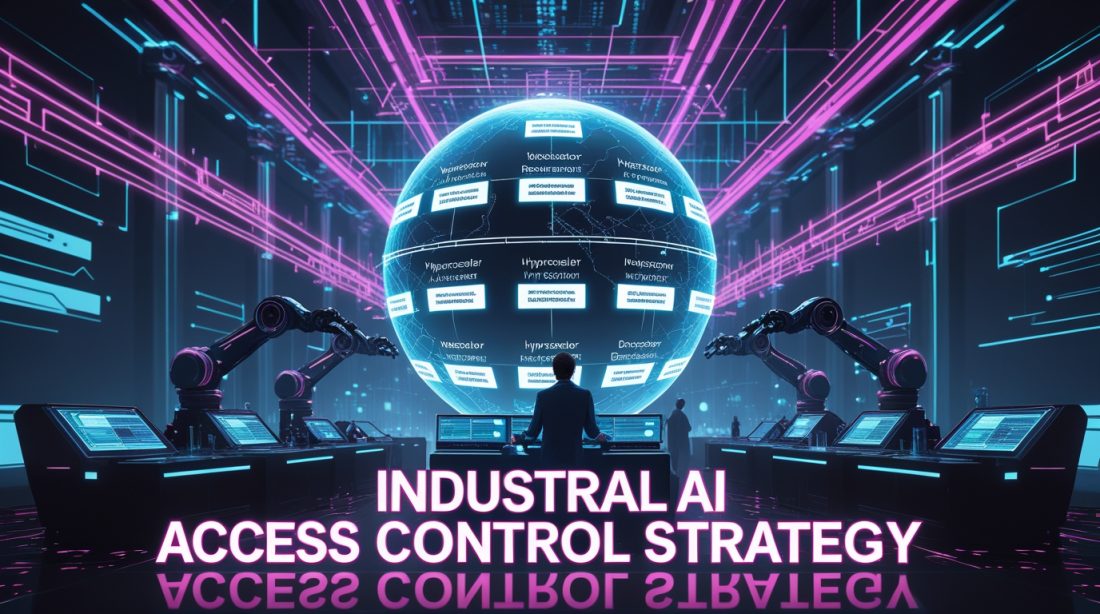The industrial AI access control strategy is quietly creating winners and losers in a high-stakes landscape where access—and its price—defines success.
The Strategic Engine of Industrial AI: Why Access Control Creates Tiered Revenue
If you’ve wondered how major AI hosting providers like CoreWeave, AWS, and Azure build their billion-dollar revenue streams while serving everything from hyperscalers to small manufacturers, the answer lies in a sophisticated tiered partnership strategy. This isn’t accidental—it’s a carefully engineered system where technical access controls directly enable revenue stratification.
In industrial AI, where the market is projected to grow from $43.6 billion in 2024 to $153.9 billion by 2030, how platforms control and meter access to their resources determines not only their profitability but also which industrial companies can leverage AI effectively .
The fundamental shift is this: AI hosting platforms have evolved from simple infrastructure providers to ecosystem orchestrators. They use granular technical controls—role-based access, network isolation, API rate limiting, and compliance boundaries—to create distinct partnership tiers with corresponding revenue streams. This architecture allows a single platform to simultaneously serve Microsoft’s need for supplemental GPU capacity, an automation vendor’s requirement for embedded AI, and a manufacturer’s demand for pre-trained quality inspection models—all while extracting different margin percentages from each relationship .
The Industrial AI Context: Why Partnership Strategies Matter Now
Understanding why this tiered approach dominates industrial AI requires examining the unique characteristics of this sector. Unlike consumer AI, industrial applications demand explainability, safety, and measurable ROI—often with 9-digit savings reported by companies like Renault and Georgia-Pacific through targeted AI implementations .
Consider these industrial AI market dynamics:
- Spending disparities: Manufacturers currently allocate only 0.1% of revenue to AI investments, creating intense pressure to demonstrate clear returns before scaling
- Skill gaps: 45% of manufacturers cite “lack of internal expertise” as their top adoption barrier, making partner-enabled solutions increasingly essential
- Use case concentration: Quality inspection leads industrial AI applications at 11% market share, dwarfing GenAI use cases at under 5% combined
This context explains why manufacturers increasingly rely on hosting platforms and their partner ecosystems rather than building capabilities in-house. The platforms, in turn, have responded by creating precisely calibrated access tiers that align with how different partners create and capture value.
How the Industrial AI Access Control Strategy Powers Tiered Revenue Models Across Hosting Platforms

The machinery behind tiered revenue models consists of layered technical controls that determine exactly what each partner can access, modify, and deploy within a hosting platform.
Identity and Role-Based Access Controls (RBAC)
At the foundation lies Identity and Access Management (IAM), which platforms like Runpod implement through granular role-based access controls. These systems define precisely who can view, edit, or execute containers and notebooks—creating the fundamental boundaries between partnership tiers .
A platform might configure:
- Basic API access for developers testing individual models
- Container management permissions for solution providers deploying integrated systems
- Infrastructure orchestration rights for hyperscalers managing supplemental capacity
As one security expert notes, “Never hardcode credentials in scripts or Dockerfiles” and “always audit and rotate access credentials regularly to mitigate potential misuse”—practices that become increasingly critical as access privileges expand across tiers .
Network and Data Isolation Controls
Beyond user permissions, platforms implement network segmentation and data isolation to enforce partnership boundaries. CoreWeave’s Virtual Private Clouds (VPCs), Direct Connect, and GPUDirect RDMA over InfiniBand create performance-isolated environments where partners can operate without interfering with—or accessing—other partners’ workloads .
These technical controls directly enable premium pricing tiers. As the IoT Analytics team explains, manufacturers are “rethinking their data storage architectures by breaking down legacy silos and creating unified data lakes, also known as lakehouses” that maintain strict access boundaries while enabling broader data utilization .
Compliance and Certification Boundaries
For industrial applications, compliance certifications serve as both security measures and partnership gates. Platforms invest in SOC 2 Type II, GDPR, HIPAA, and industry-specific certifications that become available only to higher-tier partners.
Runpod’s achievement of SOC 2 Type II compliance, for instance, isn’t just a security feature—it’s a revenue enabler that allows them to command premium pricing from regulated manufacturers in automotive, aerospace, and healthcare sectors.
The Three Primary Partnership Tiers and Their Revenue Models
AI hosting platforms typically structure their partnership ecosystems into three distinct tiers, each with specialized access controls and corresponding revenue streams.
Tier 1: Hyperscaler & Technology Alliances
At the apex are partnerships with hyperscalers and foundational AI companies—relationships like CoreWeave’s contracts with Microsoft (representing 62% of 2024 revenue) and OpenAI. These involve multi-year, multi-billion-dollar commitments for supplemental GPU capacity and specialized infrastructure .
Revenue mechanics:
- Committed spend contracts with minimum volume guarantees
- Equity investments deepening strategic alignment
- Custom infrastructure development for specific model architectures
These partnerships represent the highest revenue per relationship but require first-to-market GPU access (CoreWeave was among the first with NVIDIA GB300 NVL72 and Blackwell GPUs) and ability to operate at massive scale .
Tier 2: Solution Provider & System Integrator Channels
The middle tier consists of industrial solution providers and system integrators—companies like Accenture, which completed over 2,000 GenAI projects in fiscal year 2025 alone . These partners embed hosting platform capabilities into broader industrial solutions for manufacturing clients.
Revenue mechanics:
- Volume-based pricing with tiered discounts
- Revenue sharing on joint solutions
- Referral fees for directed business
For this channel, platforms implement container-based environments with restricted access and specialized APIs that allow integration into larger industrial systems while maintaining platform control .
Tier 3: Marketplace & Developer Ecosystems
The broadest tier encompasses independent developers, model creators, and specialized AI startups accessing platforms through marketplace arrangements. Hugging Face’s ecosystem exemplifies this approach, offering 400,000+ pre-trained models with one-click deployment while managing versioning, monitoring, and billing .
Revenue mechanics:
- Platform fees on marketplace transactions (typically 10-30%)
- Usage-based revenue sharing with model creators
- Royalty structures for specialized model access
As the IoT Analytics team notes, “GenAI poised to comprise quarter of industrial AI projects,” creating expanding marketplace opportunities for specialized industrial models .
Table: Comparison of AI Hosting Partnership Tiers and Revenue Models
| Partnership Tier | Primary Revenue Streams | Key Access Controls | Industrial Use Cases |
|---|---|---|---|
| Hyperscaler & Technology Alliances | Committed spend contracts, Equity investments, Custom development | Dedicated infrastructure, Private APIs, Custom SLAs | Supplemental GPU capacity, Large-model training, Mission-critical inference |
| Solution Provider & System Integrator | Volume discounts, Revenue sharing, Referral fees | Container-based RBAC, Integration APIs, Isolated networking | Quality inspection systems, Predictive maintenance, Automated optical inspection |
| Marketplace & Developer Ecosystems | Platform fees, Usage-based sharing, Royalty structures | API rate limiting, Model versioning, Usage metering | Specialized AI models, Domain-specific fine-tuning, Rapid prototyping |
Strategic Implications for the Industrial AI Landscape

This tiered partnership approach creates distinct competitive dynamics that will shape industrial AI adoption through 2025 and beyond.
For AI Model Creators and Solution Providers
The proliferation of marketplaces creates both opportunities and challenges for model creators. As one analysis notes, “For model authors, the marketplace proposition is compelling. They get access to customers, simplified billing, and reduced operational burden. But the trade-off is relinquishing control over pricing dynamics and customer relationships” .
Specialized industrial AI providers must carefully select platforms based not just on technical capabilities but on marketplace governance, revenue sharing terms, and access to target customer segments.
For Industrial AI Buyers
Manufacturers implementing AI face critical decisions about which platforms and partners to leverage. The IoT Analytics research indicates that “firms are no longer treating data management as an IT function, nor as a byproduct of OT installations. Instead, industrial data management is becoming an increasingly strategic pillar of digital transformation in its own right” .
Buyers should evaluate potential platforms based on:
- Integration capabilities with existing industrial systems
- Transparent pricing without hidden egress or API charges
- Compliance support for their industry and geography
- Partner ecosystems with proven industrial expertise
For AI Hosting Platforms
The competitive landscape pushes platforms to continuously refine their partnership strategies. Success requires balancing several tensions:
- Standardization vs. Customization in access controls
- Platform control vs. Partner autonomy
- Revenue maximization vs. Ecosystem growth
Platforms that adopt “standards for model packaging and runtime APIs will attract enterprise customers using multicloud or hybrid strategies,” while those that don’t will find their growth constrained to lab environments rather than large-scale production .
The Future of Tiered AI Partnerships
The stratification of AI hosting revenue through partner access controls represents more than a business model innovation—it’s a necessary adaptation to the complex, specialized world of industrial AI. As manufacturers increase AI spending from today’s 0.1% of revenue toward more substantial investments, these tiered partnerships will determine which companies successfully scale beyond pilot projects to enterprise-wide transformation.
The platforms that thrive will be those that master the delicate balance of providing standardized access while enabling custom solutions, maintaining security while facilitating innovation, and capturing value while sharing sufficient rewards with their partners. In industrial AI, where reliability and ROI trump technological novelty, the platforms that get this balance right will become the invisible infrastructure upon which the next generation of manufacturing competitiveness is built.
Frequently Asked Questions (FAQ)
How do partner access controls directly generate revenue for AI hosting platforms?
Access controls enable platforms to create differentiated service tiers with corresponding pricing. By implementing role-based access, network isolation, and API rate limiting, platforms can offer everything from basic model hosting to fully customized infrastructure—each with progressively higher price points and margin profiles.
What percentage of AI hosting revenue typically comes from top-tier partnerships?
While exact percentages vary by platform, CoreWeave’s disclosure that Microsoft alone represented 62% of their 2024 revenue indicates how concentrated revenue can be in top-tier partnerships. Typically, the top 5-10% of partners generate 70-80% of revenue in tiered AI hosting models.
How do manufacturers benefit from these tiered partnership models?
Tiered partnerships allow manufacturers to access AI capabilities through appropriate channels for their needs and scale. Rather than building expertise internally—when 45% cite lack of internal knowledge as their top barrier—they can work with solution providers who have pre-integrated access to hosting platforms.
What’s the difference between marketplace and solution provider partnerships?
Marketplace partnerships focus on transactional model access with platform fees typically ranging from 10-30%, while solution provider relationships involve deeper technical integration with revenue sharing based on overall solution value rather than just AI component usage.
How important are compliance certifications in tiered AI hosting?
Extremely important. SOC 2 Type II, GDPR, and industry-specific certifications serve as both security measures and partnership gates. Platforms use compliance boundaries to enforce tier separation while enabling regulated manufacturers to adopt AI solutions with confidence.
Fast Facts
AI hosting platforms create tiered revenue through an industrial AI access control strategy that leverages technical mechanisms—RBAC, network isolation, API limits—to define distinct partnership tiers and pricing models. Hyperscaler partnerships generate billions via committed contracts, solution providers share revenue through integrated offerings, and marketplace participants pay platform fees. In industrial AI’s specialized landscape, these controls determine who accesses what capabilities at what price point.
Want to understand how these partnership models specifically apply to manufacturing and industrial AI applications? Subscribe to our newsletter for monthly analysis on industrial AI adoption strategies.
Further reading
- Industrial AI Business Transformation: How Service Companies Are Selling Intelligence, Not Labor
- 5 Compelling Reasons the AI Partnership Revenue Share Model Is Dominating in 2025
- The Rise of the Industrial AI Data Marketplace
- SingularityNET’s Industrial AI Marketplace Surge
- How White-Label AI Dashboards Are Reshaping Industrial Markets


